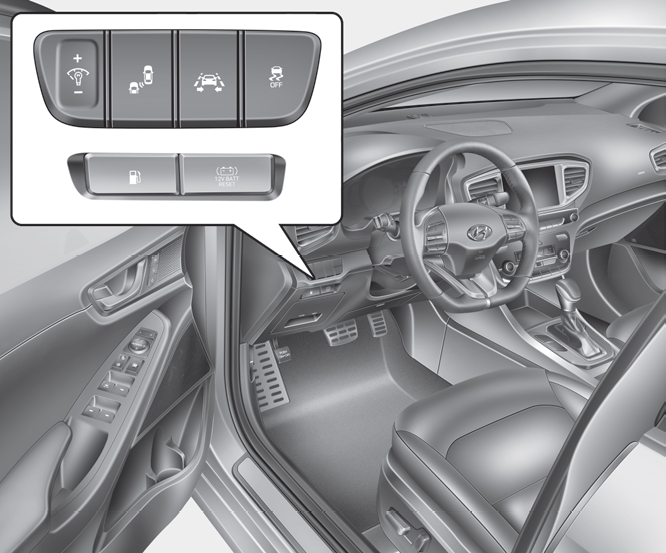Hyundai Ioniq: Brake System / Repair procedures
| Operation and Leakage Check |
Check all of the following items :
| Component | Procedure |
| Integrated Brake Actuation Unit (IBAU) (A) and Pressure Source Unit (PSU) (B) | Check brake operation by applying the brakes during a test drive. If the brakes do not work properly, check the IBAU and PSU. Replace IBAU and PSU as an assembly if it does not work properly or if there are signs of leakage. |
| Piston cup and pressure cup inspection (B) | Check brake operation by applying the brakes. Look for damage or signs of fluid leakage. Replace the IBAU as an assembly if the pedal does not work properly or if there is damage or signs of fluid leakage. |
| Brake hoses (C) | Look for damage or signs of fluid leakage. Replace the brake hose with a new one if it is damaged or leaking. |
| Caliper piston seal and piston boots (D) | Check brake operation by applying the brakes. Look for damage or signs of fluid leakage. If the pedal does not work properly, the brakes drag, or there is damage or signs of fluid leakage, disassemble and inspect the brake caliper. Replace the boots and seals with new ones whenever the brake caliper is disassembled. |

| Bleeding of Brake System |
Air Bleeding Tool Installation Procedure
|
| 1. | Before installing the SST on the vehicle, close the airshut-off valve (A) to adjust the pressure gauge to thestandard value.
|
| 2. | After connecting an air hose and opening the airshut-off valve (A), adjust the pressure gauge (B) to the standard value.
|
| 3. | Close the air shut off valve (A) and remove the plug(B).
|
| 4. | Remove the brake reservoir tank cap. |
| 5. | Install the cap (A) of SST (0k585-E8100) on the reservoir tank.
|
| 6. | Make sure the check valve is closed and connect SST (09580-3D100) (A) to the adapter (B).
|
Air Bleeding Tool Removal Procedure
| 1. | To remove the SST (09580-3D100) from the vehicle, close the air shut-off valve (A).
|
| 2. | Remove SST (09580-3D100) (A) and the cap of SST (0k585-E8100) (B) on the reservoir tank.
|
| 3. | Install the brake reservoir tank cap. |
Brake System (Judder Inspection)

Bleeding of Brake System
|
| 1. | Make sure the brake fluid in the reservoir is at the MAX (upper) level line. |
| 2. | Have someone slowly pump the brake pedal several times, and then apply pressure. |
| 3. | Loosen the right-rear brake bleed screw (A) to allow air to escape from the system. Then tighten the bleed screw securely. [Front]
[Rear]
|
| 4. | Repeat the procedure for wheel in the sequence shown below until air bubbles no longer appear in the fluid.
|
| 5. | Refill the master cylinder reservoir to MAX (upper) level line. |
 Brake System
Brake System
..
Other information:
Hyundai Ioniq (AE) 2017-2025 Service Manual: Rear Door Module. Repair procedures
Replacement1.Remove the rear door window glass.(Refer to Rear Door - "Rear Door Window Glass")2.Remove the rear door outside handle.(Refer to Rear Door - "Rear Door Outside Handle")3.Loosen the rear door outside handle base mounting bolt (A). Tightening torque : 2...
Hyundai Ioniq (AE) 2017-2025 Service Manual: Sub Frame. Repair procedures
Removal1.Loosen the bolt (A) and then disconnect the universal joint assembly from the pinion of the steering gear box. Tightening torque : M8 BOLT : 32.4 - 37.3 N.m (3.3 - 3.8 kgf.m, 23.9 - 27.5 lb-ft) M10 BOLT : 49...
Categories
- Manuals Home
- 1st Generation Ioniq Owners Manual
- 1st Generation Ioniq Service Manual
- Washer Fluid
- Temperature control
- Smart Cruise Control System
- New on site
- Most important about car
Hybrid Vehicle Interior Overview

1. Door lock/unlock button
2. Driver position memory system
3. Side view mirror control switch
4. Central door lock switch
Copyright © 2025 www.hioniqae.com












